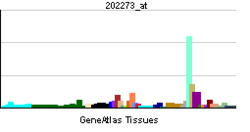PDGFRB
| View/Edit Human | View/Edit Mouse |
Beta-type platelet-derived growth factor receptor is a protein that in humans is encoded by the PDGFRB gene.
Function
This gene encodes a cell surface tyrosine kinase receptor for members of the platelet-derived growth factor family. These growth factors are mitogens for cells of mesenchymal origin. The identity of the growth factor bound to a receptor monomer determines whether the functional receptor is a homodimer or a heterodimer, composed of both platelet-derived growth factor receptor alpha and beta polypeptides. This gene is flanked on chromosome 5 by the genes for granulocyte-macrophage colony-stimulating factor and macrophage-colony stimulating factor receptor; all three genes may be implicated in the 5q- syndrome. A translocation between chromosomes 5 and 12, that fuses this gene to that of the translocation, ETV6, leukemia gene, results in chronic myeloproliferative disorder with eosinophilia.[4]
Interactions
PDGFRB has been shown to interact with:
See also
References
- ↑ "Drugs that physically interact with Platelet-derived growth factor receptor beta view/edit references on wikidata".
- ↑ "Human PubMed Reference:".
- ↑ "Mouse PubMed Reference:".
- ↑ "Entrez Gene: PDGFRB platelet-derived growth factor receptor, beta polypeptide".
- ↑ Matsumoto T, Yokote K, Take A, Takemoto M, Asaumi S, Hashimoto Y, Matsuda M, Saito Y, Mori S (April 2000). "Differential interaction of CrkII adaptor protein with platelet-derived growth factor alpha- and beta-receptors is determined by its internal tyrosine phosphorylation". Biochem. Biophys. Res. Commun. 270 (1): 28–33. doi:10.1006/bbrc.2000.2374. PMID 10733900.
- ↑ Yamamoto M, Toya Y, Jensen RA, Ishikawa Y (March 1999). "Caveolin is an inhibitor of platelet-derived growth factor receptor signaling". Exp. Cell Res. 247 (2): 380–8. doi:10.1006/excr.1998.4379. PMID 10066366.
- 1 2 3 Braverman LE, Quilliam LA (February 1999). "Identification of Grb4/Nckbeta, a src homology 2 and 3 domain-containing adapter protein having similar binding and biological properties to Nck". J. Biol. Chem. 274 (9): 5542–9. doi:10.1074/jbc.274.9.5542. PMID 10026169.
- ↑ Arvidsson AK, Rupp E, Nånberg E, Downward J, Rönnstrand L, Wennström S, Schlessinger J, Heldin CH, Claesson-Welsh L (October 1994). "Tyr-716 in the platelet-derived growth factor beta-receptor kinase insert is involved in GRB2 binding and Ras activation". Mol. Cell. Biol. 14 (10): 6715–26. doi:10.1128/mcb.14.10.6715. PMC 359202
 . PMID 7935391.
. PMID 7935391. - ↑ Tang J, Feng GS, Li W (October 1997). "Induced direct binding of the adapter protein Nck to the GTPase-activating protein-associated protein p62 by epidermal growth factor". Oncogene. 15 (15): 1823–32. doi:10.1038/sj.onc.1201351. PMID 9362449.
- ↑ Li W, Hu P, Skolnik EY, Ullrich A, Schlessinger J (December 1992). "The SH2 and SH3 domain-containing Nck protein is oncogenic and a common target for phosphorylation by different surface receptors". Mol. Cell. Biol. 12 (12): 5824–33. doi:10.1128/MCB.12.12.5824. PMC 360522
 . PMID 1333047.
. PMID 1333047. - ↑ Chen M, She H, Davis EM, Spicer CM, Kim L, Ren R, Le Beau MM, Li W (September 1998). "Identification of Nck family genes, chromosomal localization, expression, and signaling specificity". J. Biol. Chem. 273 (39): 25171–8. doi:10.1074/jbc.273.39.25171. PMID 9737977.
- ↑ Chen M, She H, Kim A, Woodley DT, Li W (November 2000). "Nckbeta adapter regulates actin polymerization in NIH 3T3 fibroblasts in response to platelet-derived growth factor bb". Mol. Cell. Biol. 20 (21): 7867–80. doi:10.1128/mcb.20.21.7867-7880.2000. PMC 86398
 . PMID 11027258.
. PMID 11027258. - ↑ Rupp E, Siegbahn A, Rönnstrand L, Wernstedt C, Claesson-Welsh L, Heldin CH (October 1994). "A unique autophosphorylation site in the platelet-derived growth factor alpha receptor from a heterodimeric receptor complex". Eur. J. Biochem. 225 (1): 29–41. doi:10.1111/j.1432-1033.1994.00029.x. PMID 7523122.
- ↑ Seifert RA, Hart CE, Phillips PE, Forstrom JW, Ross R, Murray MJ, Bowen-Pope DF (May 1989). "Two different subunits associate to create isoform-specific platelet-derived growth factor receptors". J. Biol. Chem. 264 (15): 8771–8. PMID 2542288.
- ↑ Keilhack H, Müller M, Böhmer SA, Frank C, Weidner KM, Birchmeier W, Ligensa T, Berndt A, Kosmehl H, Günther B, Müller T, Birchmeier C, Böhmer FD (January 2001). "Negative regulation of Ros receptor tyrosine kinase signaling. An epithelial function of the SH2 domain protein tyrosine phosphatase SHP-1". J. Cell Biol. 152 (2): 325–34. doi:10.1083/jcb.152.2.325. PMC 2199605
 . PMID 11266449.
. PMID 11266449. - ↑ Lechleider RJ, Sugimoto S, Bennett AM, Kashishian AS, Cooper JA, Shoelson SE, Walsh CT, Neel BG (October 1993). "Activation of the SH2-containing phosphotyrosine phosphatase SH-PTP2 by its binding site, phosphotyrosine 1009, on the human platelet-derived growth factor receptor". J. Biol. Chem. 268 (29): 21478–81. PMID 7691811.
- ↑ Farooqui T, Kelley T, Coggeshall KM, Rampersaud AA, Yates AJ (1999). "GM1 inhibits early signaling events mediated by PDGF receptor in cultured human glioma cells". Anticancer Res. 19 (6B): 5007–13. PMID 10697503.
- ↑ Ekman S, Kallin A, Engström U, Heldin CH, Rönnstrand L (March 2002). "SHP-2 is involved in heterodimer specific loss of phosphorylation of Tyr771 in the PDGF beta-receptor". Oncogene. 21 (12): 1870–5. doi:10.1038/sj.onc.1205210. PMID 11896619.
- ↑ Yokote K, Mori S, Hansen K, McGlade J, Pawson T, Heldin CH, Claesson-Welsh L (May 1994). "Direct interaction between Shc and the platelet-derived growth factor beta-receptor". J. Biol. Chem. 269 (21): 15337–43. PMID 8195171.
- ↑ Maudsley S, Zamah AM, Rahman N, Blitzer JT, Luttrell LM, Lefkowitz RJ, Hall RA (November 2000). "Platelet-derived growth factor receptor association with Na(+)/H(+) exchanger regulatory factor potentiates receptor activity". Mol. Cell. Biol. 20 (22): 8352–63. doi:10.1128/mcb.20.22.8352-8363.2000. PMC 102142
 . PMID 11046132.
. PMID 11046132.
Further reading
- Hart CE, Bowen-Pope DF (1990). "Platelet-derived growth factor receptor: current views of the two-subunit model". J. Invest. Dermatol. 94 (6 Suppl): 53S–57S. doi:10.1111/1523-1747.ep12875065. PMID 2161888.
- Steer EJ, Cross NC (2002). "Myeloproliferative disorders with translocations of chromosome 5q31-35: role of the platelet-derived growth factor receptor Beta". Acta Haematol. 107 (2): 113–22. doi:10.1159/000046641. PMID 11919393.
External links
- CD140B Antigen at the US National Library of Medicine Medical Subject Headings (MeSH)

